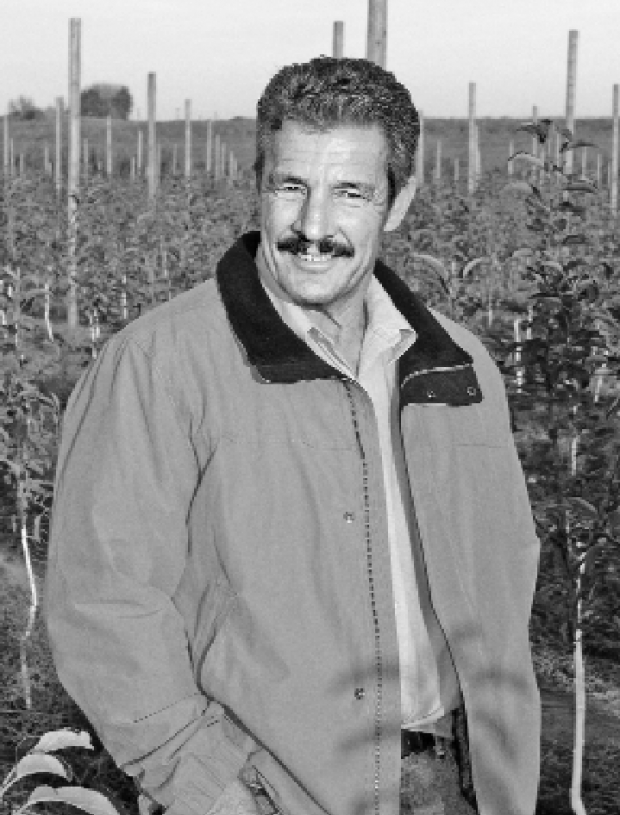
Don Weippert shared his planting techniques used to establish Braeburn and Gala apples in a replant situation during a field day organized by Washington State University.
(Melissa Hansen/Good Fruit Grower)
Don Wieppert’s replanted apple block is an example of how to get an orchard off to a strong, healthy start, with minimal expense. Washington State orchardists who toured Wieppert’s 85-acre block in Zillah, Washington, during a recent field day saw a “remarkable example of getting an orchard established quickly and for less money,” said Dana Faubion, Washington State University Cooperative Extension agent for Yakima County.
Faubion organized the orchard field day that included a visit to a rootstock trial. Describing how he established the orchard, Wieppert noted that because he acquired the block in February, he had little time before spring planting and didn’t fumigate the ground. Crops previously grown in the ground were asparagus and apples. He used bench grafts instead of nursery trees. Bench grafts are rootstocks that are harvested in the fall and have a dormant shoot of the scion grafted onto them in late winter.
They are planted out in the spring. The orchard was ripped to a depth of approximately 20 inches. Soil amendments included 50 tons of dried manure and 150 pounds of nitrogen per acre, plus a few other nutrients. Red Rocket Braeburns on Malling 9 rootstocks were planted on a 3- by 6-foot spacing. Buckeye Gala bench grafts, also on M.9 rootstocks, were planted on a 6- by 9-foot spacing.
Tree training
In the Braeburn block, he is training the trees to grow straight, reaching an overhead wire that’s 9.5 feet high. The Galas are trained to a two-leader Y, with a goal of having a leader every three feet down the orchard row. The Gala training wire is four feet from the ground. He used grow tubes on the bench grafts, primarily as protection from herbicide applications. Bamboo stakes 3/8 inch in diameter kept the grow tubes and trees in place.
Workers pulled the grow tubes up twice during the season to remove suckers from the rootstock. Grow tubes were removed in the first half of November and the trunks painted white. “I like to get the grow tubes off as soon as possible,” he said, adding that it gives trees time to acclimate before winter. He plans to reuse the grow tubes in another orchard planting. Black poly-tie tape was used to secure the trees to the training wire and prevent snow from knocking down the young trees.
The poly-tie will be removed this spring to avoid girdling the trees. Irrigation is critical in establishing young trees. Wieppert used drip irrigation with emitters that applied 0.6 gallons per hour, and ran the lines twice a day for a total of three to four hours daily.
Costs
Wieppert noted that the cost for the bench grafts ranges from $1.10 to $1.25 each, depending on where the bud wood comes from. Royalties increase the costs. He bought the grow tubes for 38 cents each and the bamboo stakes for around 3 to 4 cents each. He calculates that he spent 60 cents per tree to train it to the wire, which includes labor for two passes through the orchard to remove suckers. Pest control, which was not included in his training costs, consisted of routine mildew sprays.
Workers took care to deliver sprays inside the grow tubes, even when foliage was above the tube. Growers must pay attention to pests that may hide inside the tubes. “There are a lot of little critters that like the insides of grow tubes,” Wieppert said, adding that cutworms and rust mite can be troublesome. His goal in the Braeburn block in the coming year is to grow a big tree that will reach the 9.5-foot post. He plans to shelf cut the shoots, taking off all the side limbs, in the belief that new branches will grow with a flat break. “I think I will get strong regrowth if I do that. It’s important to get a 9.5-foot tree, especially in Braeburns.” He’s hoping for high yields from the Braeburns in the third leaf, and thinks 30 bins per acre should be possible. When the orchard is mature, he expects to harvest 60 to 70 bins per acre.
The M.9 rootstock was chosen to help add size to the fruit. In the Gala block, the two-leader system will help maintain and control the tree size, he believes. Maintaining tree width will be important. “I can’t let them get very wide, or I won’t be able to get equipment down the row,” he said. The tree height should allow about two-thirds of the crop to be picked from the ground with the remaining one-third picked by ladders or platforms. What is his pruning strategy for the Galas a year from now? “I’m hoping that it’s nothing,” he replied. A key lesson he learned was the importance of the bamboo stake diameter.
Some of the tops of the trees were laying down before they were tied and trained to the wire. “Don’t compromise on the bamboo. Make sure that you use a big enough stake that will hold the tree up,” Wieppert warns. The cost of going to the next size up is minor. Although he didn’t fumigate because of time, he is a proponent of fumigation in replant situations. Wieppert recently fumigated a 40-acre block that will be planted this spring.






Leave A Comment